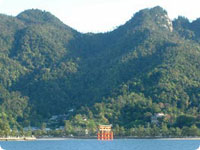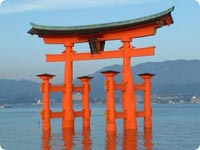 |
| MIYAJIMA |
 Miyajima has been an object of nature worship by locals since ancient times, because of its landscape, and mountains with its dominant Mt. Misen, surrounded by the primeval forest which is dark even in the daytime, making people feel a flow of spirituality.
Miyajima has been an object of nature worship by locals since ancient times, because of its landscape, and mountains with its dominant Mt. Misen, surrounded by the primeval forest which is dark even in the daytime, making people feel a flow of spirituality.The Itsukushima shrine was founded by Saeki Kuramoto who was an influential person in Saekibe during the first year of the Suiko period (593), according to the history of the shrine.
In the first year of the Daido period (806), a Buddhist priest Kukai (Kobodaishi) returned from China during the T'ang dynasty, and visited Miyajima on the way to Kyoto. He felt spirits there, and concluded the island must be a holy site, and then built a Hondo (main hall) on Mt.Misen, and took Gumonji training for one hundred days.
The fire used for the training has been kept burning in the Misen Reikado hall, called "Kiezu-no-hi” (the holy fire).
The second year of the period Kyuan (1146), Taira no Kiyomori was assigned as the head of Akinokuni.
Taira no Kiyomori accepted advice from an old priest in a dream, which was "If you build Itsukushima shrine, you will definitely achieve the highest rank". He built Itsukushima shrine with the Shinden-zukuri style of worship, and introduced Bugaku dance there from the Osaka Shitennoji temple, transcribed Hokekyo sutras with his clan, and dedicated the transcripts along with the ganmon, which is a representative national treasure known as Heike-nokyo (Heike Scrolls) today.
Also, he moved Kyoto culture to Miyajima by offering artistically-crafted articles such as armour and swords to the shrine. He gave great favour to the shrine by increasing the shrine's territory.
From Kyoto, not only the Taira clan, but also imperial families and nobles such as retired Emperors Goshirakawa and Takakura, Kenshunmonin, Kenreimonin and Chugu Tokushi came on a pilgrimage.
The Heike vanished at Dan-no-ura, however, after that, the Kamakura and Muromachi shogunates, local lords Ouchi and Mori, Toyotomi Hideyoshi also took up worship at the shrine.
The end of the Kamakura era is considered the time when people began living in Miyajima.
In the beginning Shinto priests and guso priests, and then normal people moved onto the island.
In the Sengoku period (the Civil War period), Ouchi Yoshitaka who was a powerful person in the Chugoku District, committed seppuku (hara-kiri) at Nagato-dainei-ji temple, because of the rebellion of a chief retainer, Sue Harukata.
Mori Motonari who was a sworn friend of Yoshitaka, directed his force against Harutaka, but Sue's force was far superior to his, therefore, a castle was constructed at Miyano-o located north of Miyajima to draw Sue's forces there. That happened in September of the first year of the Koji period (1555).
20,000 soldiers of Sue's force landed on Miyajima, and took up a position at Katsuyama Castle (around Taho-to) and later at To-no-oka from where Miyano-o Castle had good visibility to guard against attacks, but the stonewall defence of Mori's forces made them impossible to defeat. On 1St October, Motonari took 3,500 soldiers from the opposite shore Jigozen, to Tsutsumi-ga-ura in storm winds and darkness, and climbed Bakuchio, which is the ridge, behind To-no-oka, and defeated Sue's forces in a single onslaught.
Sue's forces were confused and just ran away. A brigadier general, Hironaka Takakane routed to Ema-ga-dake (Komagabayashi) and committed seppuku (hara-kiri). Harutaka also routed with a small number of his soldiers to Oeno-ura, and then committed seppuku. This battle is known as "Itsukushima Gassen (Battle of Miyajima)", which is one of Japans three famous sneak attacks.
Mori destroyed Sue and came to rule over 10 counties of the Chugoku District, as well as Buzen and Iyo, and became a warlord of great power.
Mori Motonari and his son Takamoto founded a tenjinsha shrine, rebuilt the Soribashi Bridge and the big Torii, replaced the corridor floor of the shrine pavilion, and donated a No stage and performed there. They contributed largely to the development of Itsukushima Shrine.
Toyotomi Hideyoshi commanded Ankokuji Ekei to found the Dai-kyodo( the great house of the Buddhist scriptures) (Senjo-kaku) to hold a memorial service for the soldiers killed in the war in the year 15 of the Tensho period(1587), but, when Hideyoshi died in the year 3 of the Keicho period(1598), the project was abandoned just before its completion. If it had been completed, it would have been a beautiful building elaborated with artistic handcrafts of the Momoyama era.
In the Edo era, Fukushima Masanori became the domain head of Akinokuni and protected the merchandise and shipping trades.
Likewise the next domain head Asano continued to protect them, consequently Miyajima became a transshipment station of trade and also a center of Setouchi cultures, such as Kabuki, Sumo-wrestling, and lotteries.
The Priest Senshin was running a rice shop, but after the peasant riot, become a Buddhist priest of the Miyajima Myoko-in and was instructed by Ryotan-shonin. Back then, many nobility, cultural figures, merchants, and worshippers had been visiting, and he realized that there weren't any industries in Miyajima; therefore he conceived the idea for wooden rice scoops, which were made in the shape of a Biwa lute instrument of Benzaiten, and spread the craft among the locals.
He also dug a well to solve a water shortage (Senshin-tsurui), and constructed a covered alley, consequently he was loved by the locals as a benefactor, and still now people speak well of him. Thus, the Senshin-daitoku-hi monument was put up to honor his virtue near to the Myoko-in shrine.
In the first year of the Keio period (1865), the second Choshu War broke out between the Choshu Domain which revered the Emperor and the anti-Shogunate, and the Tokugawa Shogunate who were trying to stop them. In the 2 years of Keio period(1866), Daigan-ji temple became the location of truce negotiations, and a cease-fire conference was held between the Shogunate naval officer Katsu Awa (Katsu Kaishu) and Hirosawa Saneomi of the Choshu Domain representatives.
In the first year of the Meiji period (1868), the Shinbutsu bunri policy (forbidding the fusion of Shinto and Buddhism) was issued, an anti-Buddhist movement called Haibutsu kishaku sprang up, temples in Miyajima became ruins except for 7 major ones. Because of this trouble, Buddhist images were relocated to other temples from the Itsukushima shrine, senjo-kaku, and goju-no-to.
 In the year 8 of the Meiji period (1876), the great trii was severely damaged and rebuilt. Selecting the material for the main pillars took many years (natural Japanese cinnamon), and was brought from Saito City of Miyazaki Prefecture and Marugame City of Kagawa Prefecture, also other material was brought from Hiroshima City and from inside Miyajima.
In the year 8 of the Meiji period (1876), the great trii was severely damaged and rebuilt. Selecting the material for the main pillars took many years (natural Japanese cinnamon), and was brought from Saito City of Miyazaki Prefecture and Marugame City of Kagawa Prefecture, also other material was brought from Hiroshima City and from inside Miyajima.The first Prime Minister Ito Hirobumi (1841~1909) worshiped Misen-sanki-daigongen and often visited Miyajima. Keigaku (the frames put up) in Misen-sanki-do hall and Daigan-ji temple were considered to be written by Ito. Moreover, Ito collected donations for temples and used his own property to maintain and improve the Misen climbing route.
In the year 12 of the Taisho period (1923), the whole of Miyajima was designated as a location of historical importance or extraordinary scenic beauty by the government, in the year 25 of the Showa period (1950), it was designated as a Setonai-kai National Park, and in December of the year 8 of the Heisei period, Itsukushima shrine as well as the Atomic Bomb Dome were registered on the World Heritage List of UNESCO (UN Educational, Scientific and Cultural Organization).
Itsukushima shrine has been repeatedly rebuilt and restored since it was founded, because of natural disasters, such as typhoons and lightning strikes, the Itsukushima Gassen (Battle of Miyajima), and the Shinbutsu bunri policy.
People still remember the shrine being damaged by the typhoon 19 in the year Heisei 3, typhoon 18 in the year Heisei 12, the Geiyo earthquake in the year Heisei 13, and typhoon 18 in September of the year Heisei 16.
Itsukushima shrine has been worshiped by fishermen, sailors and merchants, and protected by powerful people in each period.
Today, constructions listed as national treasures and important cultural properties are receiving government subsidies, as well as donations for restoration.
